On December 15, 2020, the Ministry of Health and Family Welfare notified the Cosmetic Rules 2020 (Rules) in continuation to the powers conferred upon it under the applicable provisions of the Drugs and Cosmetics Act,1940 (Act), to separately codify rules for effective compliance. It may be noted that all the licenses granted before the notification under the Drugs and Cosmetics Rules,1945 (Old Rules) will continue to be valid until the expiry date or time period of no later than 18 months from the date of the notification of these Rules.
According to the notified Rules, an 'authorized agent' means a person authorized by a manufacturer in India who is responsible for the manufacturer's business activities in India, which may include a company or a unit or a body corporate or any other establishment. No cosmetic products shall be imported into India unless the product has been registered by the Central Licensing Authority (CLSA) or any officer to whom such similar powers have been assigned.
An application for registration of a cosmetic product intended to be imported into India shall be made either by the manufacturer itself or by its authorized agent or importer in India or by a subsidiary in India authorized by the manufacturer, through the online portal of the central government in a prescribed form (Form COS-1). Once satisfied, the CLSA can issue an import registration certificate in the prescribed form (i.e. Form COS-2) or may deny an application for reasons to be documented in writing within six months of the date of application and remain valid in perpetuity, subject to payment of the retention fee for the registration certificate before the completion of the period of five years from the date of issue, unless, it is suspended or cancelled by the relevant Indian governmental authority.
Overview of the Cosmetic Rules, 2020
- New Cosmetic: The Rules have introduced the concept of a 'New Cosmetic' which was not included earlier under the Old Rules. The term 'New Cosmetic' as defined in Section 3(r) reads as 'a cosmetic which contains a novel ingredient that has not been used anywhere in the world or is not recognized for use in cosmetics in any National or International literature.' The Rules provide importers of new cosmetic to seek approval by making an application to CLSA in Form COS- 3 before registration of import of new cosmetics into India. The application shall contain the method of test or analysis to be employed for safety evaluation of new cosmetic as specified in the IS 4011: 2018 methods of test for safety evaluation of cosmetics, published by the 'Bureau of Indian Standards' as amended from time to time. If the manufacturer/importer fails to comply with any conditions of the registration, then the CLSA may after giving him an opportunity of being heard regarding why such order should not be passed, can pass an order in writing directing suspension or cancellation of registration for a certain period as it may deem fit either wholly or in respect to some cosmetics1.
- Import and Registration of Cosmetics: The process of registration and import of cosmetics remains largely unchanged, though certain significant changes have been brought forth concerning applications/forms for the same. The Rules, however, pave way for importer's who want to make a single license application and seek a single registration certificate to import one or more cosmetics produced by the same manufacturer into a single production facility, which also involves multiple factories working jointly. The Rules also call upon for prohibition of import of cosmetics, in the following cases:
-
- The manufacture, sale, or distribution of the cosmetic in question is prohibited in the country of origin;
- The 'Use Before or Use by date' is less than six months from the date of import;
- The cosmetic which contains 'hexachlorophene' (considered to have harmful effects on humans); and
- The cosmetic which has been tested on animals after November 12, 2014.
- Manufacture of Cosmetics for Sale or Distribution: The process for obtaining a license for manufacturing, sale, and distribution is majorly similar to that mentioned under the Act. In addition, the Rules mandate the applicant to provide a self-declaration affirming compliance with good manufacturing practices and other set of guidelines. It also envisages the requirement of obtaining separate licenses for each premise in situations that involve manufacturing at more than one premises. Further, parallel to import registration certificate, license for manufacturing or loan must necessarily remain valid in perpetuity and the same shall be subject to payment of retention fee before a time period of five years from the date of issuance of the license.
- Quality of Cosmetics: The Rules do not allow the import and/or manufacture of cosmetics that do not satisfy the requisite guidelines with regard to the standard of safety and quality. Certain (specified) raw materials (as provided under Annex A of the Indian Standard IS 4707 Part 2) have also been prohibited.
- Voluntary Recall Mechanism: The Rules lay an additional obligation on the manufacturer or his approved agent concerned to withdraw cosmetics from the market if the manufacturer or his authorized agent considers or has reason to believe that such cosmetics are likely to affect the health of the consumer or have any negative impact and may therefore be unsafe. In such an event, the concerned manufacturer or authorized agent must immediately withdraw such cosmetic from the market by adhering to the prescribed procedure as well as state reasons for such withdrawal and inform the 'State Licensing Authority' or the CLSA, as the situation may be.
Conclusion
The notified Rules have consolidated and enhanced the regulatory requirements surrounding the cosmetics industry. The clarifications to regulatory requirements and standards about import manufacture and distribution of cosmetics in India introduced a firm degree of regulatory certainty which was absent under the Drugs and Cosmetics Act, 1940. The Rules establish an accountability fortress engaging the liability of importers and manufacturers concerning the quality of their cosmetic products. It also levies an obligation on the inspectors to inspect the premises licensed to manufacturers of cosmetics at least once in every 3(three) years to ensure compliance to the provisions of the Act and the Rules.
A prominent development has been the digitization of the regulatory process which would result in increased efficiencies by simplifying the application process and making it less time-consuming for applicants. The entire set of additions which has been introduced have opened a window of positive incentives for this industry, thereby leading to reduction of procedural and regulatory complexities and promoting smooth governance.
Footnote
1 Refer to Section 32 (4) of the Cosmetic Rules, 2020
The content of this article is intended to provide a general guide to the subject matter. Specialist advice should be sought about your specific circumstances.


